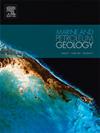受生长断层和泥底辟控制的海底水道扇形分区
IF 3.7
2区 地球科学
Q1 GEOSCIENCES, MULTIDISCIPLINARY
引用次数: 0
摘要
海底河道及其伴生的岸上沉积物具有丰富的地貌特征和极其复杂的沉积结构。确定它们在海底变形周围的分布对于更好地理解沉积物路线、网络和深海扇分区的动力学至关重要。在此,我们研究了海底河道扇形地貌演化与生长断层引起的构造变形之间的相互作用。来自尼日尔三角洲Agbada地层的Amaku海峡防波堤系统(ACLS)的良好成像地震记录为描绘裂缝对结构的响应提供了关键位置。通过对地震反射和测井数据的综合解释,我们定义了一种新型的复合裂缝,并将其命名为“叉形裂缝复合体”(FSC)。FSC由断层分流通道段引入,分布一组分支的单个片(Sp1-Sp4)。他们在低断层断层之间开发了特定的连通性区域,并在高断层断层之间划分了元素。在下游,两个扇形的裂缝(A和B)从偏转的河道段中出现,B裂缝在断层干扰下的空间分布特别旋转和拉长。在此基础上,我们提供的证据表明,尽管数字化片区的扩张程度不如叶状片区,但它们可能保持了粗沉积物厚度的稳定分布,这可能是河道向叶状片区转变(CLTZ)的主要控制因素。研究结果表明,在FSC和j通道之间的汇合带,所研究的带状带的解析模式可以作为理解构造变形如何控制斜坡沉积体系结构的原型,目的是协助地下解释和表征砂的连通性或分区化。本文章由计算机程序翻译,如有差异,请以英文原文为准。
Compartmentalization of submarine channel splays controlled by growth faults and mud diapir
Submarine channels and their associated overbank deposits can demonstrate vast array of geomorphological expressions and extremely complex depositional architectures. Defining their distribution around seabed deformation is crucial to better understand the dynamics of sediment routing, networking, and deep-sea fan compartmentalization. Here, we investigate the interactions between the geomorphological evolution of submarine channel splays and the structural deformation induced by growth faults. The well-imaged seismic records of the Amaku Channel Levee System (ACLS), from the offshore Niger Delta Agbada Formation, offers a key location to delineate the responses of splays to structures. An integrated interpretation of seismic reflection and well log data allowed us to define a new type of composite splay – named here the “Fork Splay Complex” (FSC). The FSC were introduced by a fault-diverted channel segment, distributing a set of branched individual splays (Sp1-Sp4). They develop particular zones of connectivity across low fault throws and compartmentalized elements between high fault throws. Downstream, two fan-shaped splays (Splay A and B) emerged from deflected channel segments, the Splay B is particularly rotated and elongated distally where a fault interfered its spatial distribution. Based on this study, we provide evidence that the digitated splays, while less expanded than the lobate splays, potentially maintain a stable distribution of coarse-sediment thicknesses, which is implied to be the major control on channel to lobe transition (CLTZ) –i.e., in the confluence zone between FSC and Channel J. The resolved patterns of the investigated splays serve as prototypes for understanding how structural deformation controls slope sedimentary system architectures, with the aim of assisting subsurface interpretation and characterizing sand connectivity or compartmentalization.
求助全文
通过发布文献求助,成功后即可免费获取论文全文。
去求助
来源期刊

Marine and Petroleum Geology
地学-地球科学综合
CiteScore
8.80
自引率
14.30%
发文量
475
审稿时长
63 days
期刊介绍:
Marine and Petroleum Geology is the pre-eminent international forum for the exchange of multidisciplinary concepts, interpretations and techniques for all concerned with marine and petroleum geology in industry, government and academia. Rapid bimonthly publication allows early communications of papers or short communications to the geoscience community.
Marine and Petroleum Geology is essential reading for geologists, geophysicists and explorationists in industry, government and academia working in the following areas: marine geology; basin analysis and evaluation; organic geochemistry; reserve/resource estimation; seismic stratigraphy; thermal models of basic evolution; sedimentary geology; continental margins; geophysical interpretation; structural geology/tectonics; formation evaluation techniques; well logging.
 求助内容:
求助内容: 应助结果提醒方式:
应助结果提醒方式:


